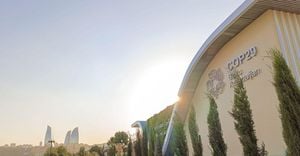Curious minds were recently captivated by a peculiar incident aboard the International Space Station (ISS), where astronauts reported detecting foul odors emanated from the Russian Progress MS-29 cargo spacecraft. This unexpected development highlights the inherent challenges of maintaining safety and cleanliness within the unique environment of space.
The sequence of events began when the Progress cargo spacecraft successfully docked with the ISS, delivering roughly 2.5 tons of supplies intended for the station's seven-person crew. Upon opening the hatch of the spacecraft, Russian cosmonauts Ivan Vagner and Aleksandr Gorbunov were met with alarming odors and small droplets of what appeared to be some unidentified liquid, triggering immediate safety protocols.
NASA swiftly acted upon notification of the matter. Crewmates aboard took no time to contain the potentially hazardous situation; the hatch connecting the Progress spacecraft to the ISS was immediately sealed to prevent any contaminant exposure. Subsequently, air scrubbers and contaminant sensors were activated to monitor the air quality throughout the station.
According to officials from NASA, the atmosphere inside the ISS remained stable and was confirmed to be safe for crew members by Sunday afternoon. The agency reassured everyone by stating, "There are no concerns for the crew...all other space station operations are proceeding as planned." Despite the initial alarm, the hazardous odors appeared to dissipate quickly.
Explaining the probable source of the unpleasant scent, NASA suggested it might have originated from outgassing materials within the Progress spacecraft. They noted, “it may have been caused by outgassing from materials inside the cargo spacecraft,” but left the precise origins of the droplets unexplained, which stirred some speculation among space enthusiasts and analysts.
During these tense moments, U.S. astronaut Don Pettit described the odor as reminiscent of spray paint pouring from the cargo hold. Though the connection between his findings and the Russian module's odors remains ambiguous, the precautionary reactions showcase the astronauts' vigilance and commitment to safety.
A vacuum of difficulty is no stranger to the crew on the ISS, especially concerning the Russian segments of the station. Just last year, the Russian Soyuz and Progress spacecraft were plagued with significant coolant leaks leading to rising tensions between NASA and Roscosmos, Russia’s space agency. These leaks spurred concern about operational safety, prompting investigations about potential external damage caused by space debris.
This latest incident reflects persisting issues involving the integrity of Russian modules. Ongoing oxygen leaks remain unaddressed, attributed to small holes within the zvezda module’s hull. Such challenges are complicated by the overarching necessity of cooperation between NASA and Roscosmos, as both entities strive to sustain human life and research aboard the ISS.
Following rigorous loss prevention protocols, astronauts aboard initiated additional protective measures, utilizing filters and wearing safety gear to mitigate any risks. The quick actions of both teams ensured the continuity of operations on the ISS, where scientific work proceeds undeterred.
It is noteworthy how this case underlines the complexity of living and working in space. Despite rigorous training and preparation, unexpected challenges continuously test the resolve of astronauts as they navigate daily life aboard the space station. Such incidents not only demonstrate the intricacies of space missions but also highlight the need for constant vigilance and quick response to potential hazards.
The return to normalcy post-incident reaffirms the effectiveness of the established safety protocols and the collaborative spirit bridging two powerful space agencies. Along with maintaining progress toward scientific discoveries, they must manage the pressing realities of living in confined and sometimes precarious environments.
Although the issues stemming from the Russia-docked spacecraft may have caused alarm among the crew and monitoring agencies, they also serve as reminders. The quest for knowledge and exploring the vast universe is fraught with challenges; safety must always remain at the forefront of human space exploration.
Therefore, as the Progress spacecraft remains docked, crew members continue to engage with their numerous scientific projects and research initiatives. Each day aboard the ISS will always carry with it the intrigue of potential discoveries alongside the pragmatic management of operational safety.
Going forward, the lessons learned from this experience may resonate within future operational protocols as both NASA and Roscosmos maintain vigilance against the unpredictable nature of space exploration. With unwavering efforts, both agencies are committed to ensuring the safety and success of their missions as they push the boundaries of human knowledge and endurance.



